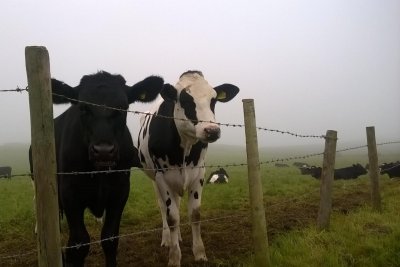News • Sustainable Farming Campaign
New US policy on antibiotics in farm animals criticised by experts
America's food standards regulator, the Food and Drug Administration (FDA), has announced that it will help US farmers to phase out unnecessary use of antibiotics in farm animals, in a bid to prevent the loss of medicines vital for treating human disease. However, experts working on the issue of antibiotic resistant bacteria have welcome the new policy only cautiously, whilst others have expressed disappointment at flaws in the FDA's plan.
The FDA's press release states that the agency will start implementing a plan, "to help phase out the use of medically important antimicrobials in food animals for food production purposes, such as to enhance growth or improve feed efficiency”. The release also states that veterinarians will oversee the remaining uses of antibiotics in animal feed. Farm practices such as use of antibiotics to enhance animal growth, cut animal feed costs, and speculatively to reduce the risk of future disease, are known as 'prophylactic', and are widespread in intensive farming. Such widespread and non-essential use of antibiotics is giving rise to antibiotic resistance in bacteria, and in some cases creating 'superbugs' that pose a severe threat to human health.
"The main disappointment for me is the very explicit endorsement of what is effectively routine prophylactic use”, says Cóilín Nunan, Antibiotics Adviser to the Soil Association and the Alliance to Save Our Antibiotics. The FDA policy, he points out, defines "judicious use" of antibiotics for preventive purposes very loosely by allowing it even when a veterinarian decides that animals might get a bacterial infection due to farm and animal transport practices. “In other words, using antibiotics preventatively as a tool to prop up deficient production practices is still considered responsible use despite the current resistance crisis,” says Nunan.
The FDA is lagging well behind many European countries on control of prophylactic use of antibiotics in farming. In Europe, routine preventative use is still practised in most countries, but governments are beginnning to take action. According to Nunan, “In most European countries, progress is also far too slow, but we are seeing some signs of change. Countries like Denmark, the Netherlands and France have set targets for reducing antibiotic use, and Ireland is the latest country considering setting targets.”
The new FDA policy does discourage adding antibiotics to feed or water in the absence of any recognised disease risk, but goes no further to discourage routine prophylactic use. There are also no targets for reducing overall antibiotic use. Further, in its draft Veterinary Feed Directive, whilst requiring veterinarians to oversee use of antibiotics in animal feed, the FDA has failed to require veterinarians to approve this use only in the presence of diagnosed or observed disease in farm animals.
Another physician expert, David Wallinga, Director of Healthy Food Action, points out that even this modest new FDA policy has taken over two years to develop and that it has been 35 years since the FDA first issued a warning that continued use of the antibiotics penicillins and tetracyclines in animal feed was unsafe.
“This policy is still only a guideline for the industry, that lays out a process whereby FDA hopes the industry will participate in voluntarily withdrawing certain of its antibiotic products that are sold in animal feed for uses like growth promotion,” said Wallinga. According to Wallinga, some of those same products can continue to be used at the same dosage under the claim of "disease prevention", and these uses can continue without there having to be any proof that the farm animals have a diagnosed disease or imminent threat of disease.
Further, the FDA has said that within 90 days they will report out on whether or not industry is going along with this plan, while giving the industry 3 years to implement the plan. So, says Wallinga, "It will be 3 years until the FDA will be willing to say whether this plan even works. The only way to really know will be if we see dramatic drops in the amount of antibiotics sold for use in animal agriculture. However, FDA is still putting up roadblocks to reporting out that data in a way that will make it easy to draw any conclusions.”
Cautious optimism was expressed by Richard Young, Policy Coordinator of the Sustainable Food Trust, who has worked on the issue of antibiotic use in farm animals for several years. He said, “Despite all the weaknesses and the inevitable disappointment of US campaigners who have been trying to get meaningful change for such a long time, there is something here that can be built on, and as such it could became very useful in efforts to raise awareness more widely amongst consumers.”
Young feels that the new policy recognises that over-using antibiotics on farms can cause resistance problems that threaten human health, and that as a result these medicines should not be used on American farms for non-medical reasons. Young also suggests that the change in influential US farm policy, however imperfect, will make it easier to get the use of antibiotics for growth promotion stopped worldwide, something the United Nations World Health Organization (WHO) has called for. “At the moment about half of all countries still allow this,” says Young.
But Young also feels that over time there will now be progressive improvements. He gives the example of how, in 2012, UK regulators admitted that many farmers had been flouting the rules by asking feed suppliers to add antibiotics without ever speaking to their veterinarian. Suppliers would then either forge prescriptions or write them out themselves, usually incompletely or incorrectly. Veterinarians would then be forced to sign and return prescriptions without any time to contact the farmer, due to time pressures expressed by the supplier or farmer.
Young also cautions that, realistically, we should expect that the sort of systems that routinely use antibiotics in farm animals will have a challenging job to manage without them. They could make some improvements by, for example, increasing hygiene, weaning pigs later, and using more probiotics, but the only reliable way to stop the unnecessary and unsafe use of antibiotics is to keep the animals much less intensively. “That’s only going to happen when there is much greater consumer awareness of the antibiotic resistance issue across the board and its true cost to society,” says Young.
Read details of the FDA antibiotics story in the New York Times
Published Thursday 19 December 2013
Sustainable Farming Campaign: Sustain encourages integration of sustainable food and farming into local, regional and national government policies.





